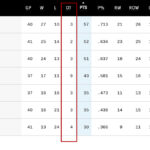You’re watching the hockey game and it’s tied 3-3 with time running out in the third period. So, what happens next? We know the game isn’t simply going to end this way – it just seems so incomplete.
Well, your hunch is right. The game is headed to overtime, but how long is it going to take?
We’re here to explain that as not every hockey game is the same.
How Long is Overtime in Hockey?
In the NHL, overtime is 5 minutes long for all regular season hockey games. However, during the playoffs, teams play 20-minute overtime periods until a goal is scored. This is known as sudden death overtime where a winner for the game must be declared.
There are other differences between regular season and playoffs overtime games.
Overtime Hockey (and Shootout) in the Regular Season
During the regular season, overtime is played 3-on-3 with teams playing at opposite sides of their bench. That is, the goalie defends the net on the opposing side of center line to their team bench.
Should a penalty or two be called, the team on the powerplay can have one (or two) additional players on the ice. In other words, the team would have a 4-on-3 or 5-on-3 powerplay.
Lastly, if the disadvantaged were to kill off the penalty, the penalized player can return to the ice and game will continue 4-on-4, 5-on-4 or 5-on-5 until the next whistle is called.
Once the game resumes, teams must adjust their player counts back to three players aside.
If neither team scores in overtime in the regular season, the game heads to a shootout. The shootout continues until a winner is declared.
The shootout begins with 3 shooters on each side and the team with the most goals wins the game. Should the game remain tied after 3 rounds, teams play one round at a time until a winner is declared.
Overtime Hockey in Playoffs
During the playoffs, teams continue 5-on-5 play unless, of course, a penalty is called. That said, teams continue to play just as they would during regulation time (first 3 periods). The game stops once the next team scores, which is why it is called sudden death overtime. Whoever breaks the tie in overtime wins the game.
Is the Shootout Considered Part of Overtime?
Generally speaking, the shootout is separate from overtime because of the gameplay format.
However, in terms of team standings, a loss in overtime or shootout is listed in the OT column. The OT column stands for Overtime/Shootout Losses, which is separate from regulation losses.
Teams that lose in overtime or shootout earn 1 point, while 0 points are awarded for regulation losses.
If you'd like to learn more about team win, loss and overtime columns, make sure to check out my blog here on What are the Three Numbers in Hockey Standings.
Furthermore, the ROW column dictates that there is no difference between an overtime or shootout win.
ROW stands for regular + overtime wins. In this case, “overtime wins” encompass victories during the overtime period only (shootout wins excluded).
If you’d like to read up more the details, please check out my blog post about What Does ROW Mean in Hockey Standings.
As a teaser, if two (or more) teams finished the season tied in points, the ROW column plays a factor in the order of team standings.
History of Overtime Length
The first known change to overtime in the NHL happened in the 1921-22 season, where overtime was fixed to 20 minutes.
In 1927-28, 10-minute sudden overtimes were played following a tie game in regulation time.
In 1928-29, the overtime rule was changed again to a 10-minute without the sudden death provision. If neither team scored, the game would end in a tie.
In the 1942-43 season, during World War 2, overtime games were discontinued for regular season games (as of November 21, 1942).
By 1947-48, 20-minute sudden death overtimes were introduced for all playoff games until a winner was declared. A 10-minute intermission would separate the start of each overtime period.
In 1983-84, 5-minute sudden death was added for all regular season games. If neither team scored, the game would end in a tie.
In the 1999-2000 season, the league introduced 4-on-4 play for all regular season overtime games.
Following the lockout of 2004-05 season, the NHL brought in the shootout, which would follow a stalemate in regular season overtimes.
Finally, overtime format was reduced to 3-on-3 play as of the 2015-16 NHL season.
Longest Overtime Games in NHL History
As you might have suspected, the longest games in NHL history are all playoff games. Because of the sudden death format, these games can go on and on until one of the 2 teams finally score.
Below is a list of the top 15 longest NHL games of all time.
Some of these games would equate to almost 3 full games if they finished in the normal three periods (60 minutes) of play.
List of the 15 Longest NHL Overtime Games
| Date | Home Team | Opposition | Score | Total Length (MMM:SS) | Overtime Periods | |
|---|---|---|---|---|---|---|
| 1 | March 24, 1936 | Montreal Maroons | Detroit Red Wings | 0-1 | 176:30 | 6 |
| 2 | April 3, 1933 | Toronto Maple Leafs | Boston Bruins | 1-0 | 164:46 | 6 |
| 3 | May 4, 2000 | Pittsburgh Penguins | Philadelphia Flyers | 1-2 | 152:01 | 5 |
| 4 | August 11, 2020 | Tampa Bay Lightning | Columbus Blue Jackets | 3-2 | 150:27 | 5 |
| 5 | April 24, 2003 | Dallas Stars | Anaheim Mighty Ducks | 3-4 | 140:48 | 5 |
| 6 | April 24, 1996 | Washington Capitals | Pittsburgh Penguins | 2-3 | 139:15 | 5 |
| 7 | April 11, 2007 | Vancouver Canucks | Dallas Stars | 5-4 | 138:06 | 4 |
| 8 | March 23, 1943 | Detroit Red Wings | Toronto Maple Leafs | 2-3 | 130:18 | 4 |
| 9 | May 4, 2008 | Dallas Stars | San Jose Sharks | 2-1 | 129:03 | 4 |
| 10 | March 28, 1930 | Montreal Canadiens | New York Rangers | 2-1 | 128:52 | 4 |
| 11 | April 18, 1987 | Washington Capitals | New York Islanders | 2-3 | 128:47 | 4 |
| 12 | April 27, 1997 | Buffalo Sabres | New Jersey Devils | 1-0 | 125:43 | 4 |
| 13 | March 27, 1951 | Detroit Red Wings | Montreal Canadiens | 2-3 | 121:09 | 4 |
| 14 | March 27, 1938 | New York Rangers | New York Americans | 2-3 | 120:40 | 4 |
| 15 | March 26, 1932 | Montreal Canadiens | New York Rangers | 3-4 | 119:32 | 3 |
Final Thoughts
The NHL has tinkered with the overtime rules to make tie game more exciting. At least for regular season games.
When I started watching the game, it was played 5-on-5 for five minutes. If the time expired, the game would end in a tie.
And both teams would share a point each in the standings.
Fast forward to today, one of the two teams must emerge victorious. The NHL settled on 3-on-3 overtime play with a shootout to follow.
While some wish the league would play sudden death overtime, even in the regular season, it wouldn't be practical for the players or the fans.
Considering games are played in the evening and kids attend, endless overtimes can become exhausting.
But that's just my opinion for regular season. Sudden death in the playoffs is a must in my books.
I remember staying up late for Montreal Canadiens playoff games as a kid, and I wouldn't have it any other way.






